General: Manual Focusing Methods
Zone Focusing | Distance Estimation | Pre-Focusing | Hyperfocal Distance | Final Word | References
In the following, I describe general manual focusing methods. The sections on zone focusing was adapted from Roger Hicks' and Frances Schultz's Photo School, the one on hyperfocal distance in part from Wikipedia.
Zone Focusing
Procedure for zone focusing with a lens that has a depth of field scale:
- Decide for the minimum and maximum distances (distance range, zone) at which the subjects that you want to photograph are likely to appear (for example, between 3 meters and 10 meters).
- Set a middle-to-small aperture (f/8 or f/11) on the lens and identify the corresponding marks on the lens' depth of field scale.
- Depending on whether the lens was made for the camera format or not do
the following:
- Lens that was made for the camera format: Turn the focusing ring so that the distance range lies within the depth of field range for the selected aperture. If the distance range does not fit, either stop the lens down further or decide for a smaller distance range.
- Full frame lens on APS-C camera (applies to Ricoh GXR M-mount expansion
unit with fullframe lens):
Turn the focusing ring so that the distance range lies within the anticipated
depth of field range for an aperture
that is one
stop slower* than the selected aperture. If the distance range
does not fit, either stop the lens down further or decide for a smaller
distance range.
*) The exact value is about 1-1.5 f-stops.
This sets the lens into a "snapshot" mode that does not require further focusing.
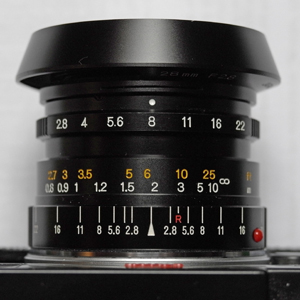 |
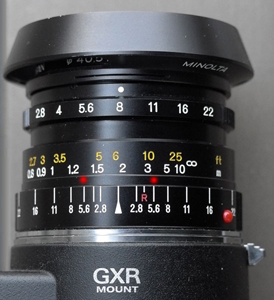 |
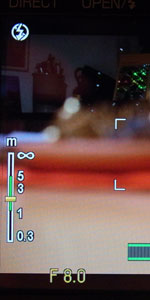 |
Photos: Zone focusing demonstrated with a manual lens at a full-frame body (at f/8, range from 1.2 m to 5 m; left), with the same lens at an APS-C body (at f/8, range from 1.3 m to 3.5 m for f/5.6; center)* and with an AF lens (at f/8, range from about 1.2 m to 5 m; right)
*) Since this is a full frame lens on an APS-C body, the depth of field range actually has to be considered for an aperture of about f/5.6 (1.3 m to 3.5 m)!
Distance Estimation
For non-moving subjects, I simply estimate the distance of the subjects and set the distance on the lens accordingly. This is easier than one might expect, particularly when using lenses with a short focal length and middle-to-small apertures. The old rule of thumb that the zone of sharpness extends to one third in front of the distance you set and two thirds beyond it does not seem apply in general. A better rule of thumb seems to be that it extends equally in both directions.
When using an Ricoh AF lens, you can use the autofocus for estimating the distance for you, provided that autofocus finds a target. Just focus with AF and then switch from automatic to manual focus ("AF/MF"). The "AF/MF" function sets the manual focus to the distance that AF has set.
Pre-Focusing
Pre-focusing can be regarded as a variant of distance estimation, namely one for moving subjects (Roger and Frances call it a variant of zone focusing, but there is no zone here...). You set your lens to the distance at which you expect the subjects to appear and wait until they come into (pre-)focus. Typical applications are sports and action photography.
For pre-focusing with a Ricoh autofocus lens, you can first use the AF to set the appropriate distance and then switch to manual focus. The "AF/MF" function sets the manual focus to the distance that AF has set. Of course, this works only in cases where AF finds focus (for example, it may not work for sky or macro photos).
Hyperfocal Distance
According to Wikipedia, definition 1 (the one that I find more useful), the hyperfocal distance is the closest distance at which a lens can be focused while keeping objects at infinity acceptably sharp. When the lens is focused at hyperfocal distance, all objects at distances from half of the hyperfocal distance out to infinity will be acceptably sharp.
But how do I know this distance for my specific lenses without having to perform calculations and brood about which circle of confusion I would accept?
In practice, I accept the circle of confusion that the lens maker decided for (there are differences between lens makers...) and proceed in the following way:
- Depending on whether the lens was made for the camera format or not do
the following:
- Lens that was made for the camera format: Select an aperture value (preferably a middle-to-small aperture like f/8 or f/11) on the lens. Then turn the distance scale so that the farther depth of field mark for this aperture is aligned with the center of the infinity symbol. This assures that everything from a certain distance up to infinity is "acceptably" sharp.
- Full frame lens at APS-C camera (applies to Ricoh GXR): Select
an aperture value on distance scale of the the lens that is one
stop slower than the aperture that you set (preferably a
middle-to-small aperture like f/8 or f/11). Then turn the distance
scale so that the farther depth of field mark for this aperture is
aligned with the center of the infinity symbol. This assures that everything
from a certain distance up to infinity is "acceptably" sharp.
*) The exact value is about 1-1.5 f-stops.
- Then look at the closer depth of field mark for the selected aperture to find out from which distance on the photo will be sharp.
Alternatively, you can set distance to infinity and read the hyperfocal distance from the "near limit" of the DOF markers (for the aperture, the same applies as above). Then set the lens to this distance.
I could confirm at DOFMaster (Hyperfocal distance) that I am correct. By the way, if you proceed as described above, you can also verify that the closer depth of field-mark is set to about half the distance that you actually indirectly set this way, namely the hyperfocal distance.
Note that this procedure only works for lenses with a depth of field scale. In all other cases more effort is needed (See DOFMaster -> Hyperfocal distance)...
Also note that setting the hyperfocal distance is most useful for wide lenses with a large depth of field.
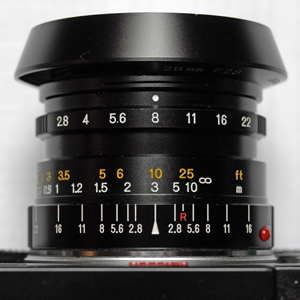 |
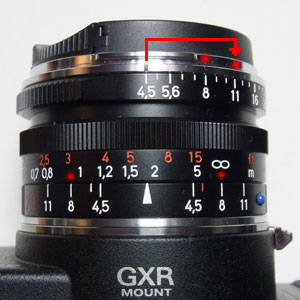 |
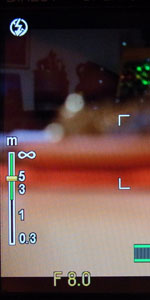 |
Photos: Hyperfocal distance demonstrated with a manual lens at a full-frame camera (at f/8, the hyperfocal distance is about 3 m, the sharpness zone ranges from about 1.5m to infinity; left) a different manual lens at an APS-C body (at f/11, you need to consider f/8; therefore, the hyperfocal distance is about 1.8 m, the sharpness zone ranges from about 0.95 m to infinity; center*), and with an AF lens (at f/8, the hyperfocal distance is about 4.5 m, the sharpness zone ranges from about 2 m to infinity; right); the latter lens is probably not set optimally.
*) Since this is a full frame lens on an APS-C body, the depth of field range actually has to be considered for an aperture of about f/8, when f/11 is set. Note that currently f/4.5 is set in the lens!
Two Methods of Finding the Hyperfocal Distance on Lenses with a DOF Scale
For full-frame cameras, using the DOF scale on the lens for determining the hyperfocal distance or the near limit when distance is set to infinity is quite easy:
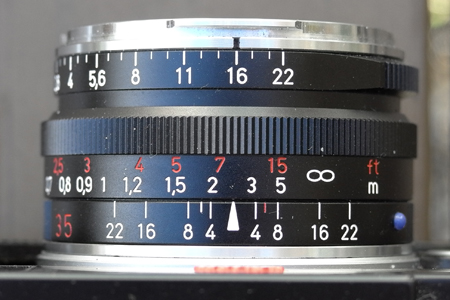 |
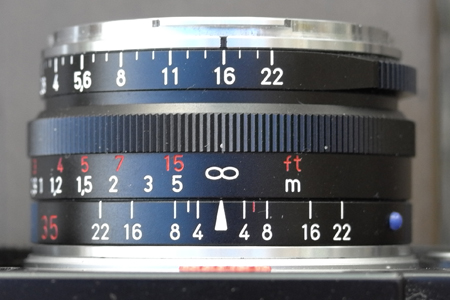 |
|
Move the infinity mark to the "far" marker for the chosen f-number - here f/16 |
Set the distance to infinity and read the near distance or hyperfocal distance from the "near" mark - here f/16 |
|
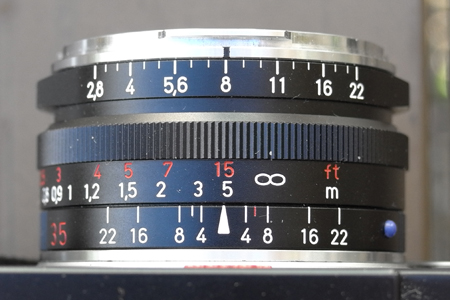 |
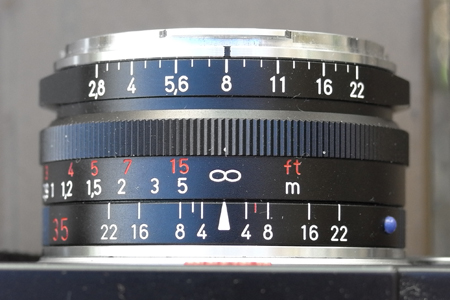 |
|
Move the infinity mark to the "far" marker for the chosen f-number - here f/8 |
Set the distance to infinity and read the near distance or hyperfocal distance from the "near" mark - here f/8 |
For ar APS-C camera with full-frame lenses (Ricoh GXR with M-mount expansion unit), you need to use an f-number that is one stop higher than the value that you actually use.
Final Word
You can mix this all up at your will: You can either decide for a distance and keep the 1:1 rule in mind, or you look for a range, which you can also manipulate so that one end is infinity (hyperfocal distance), or you simply set distance to infinity for landscape shots...
References
- Roger Hicks' and Frances Schultz's Photo School
- Hyperfocal Distance (Wikipedia)
- DOFMaster Website - Hyperfocal distance
| 18.06.2022 |